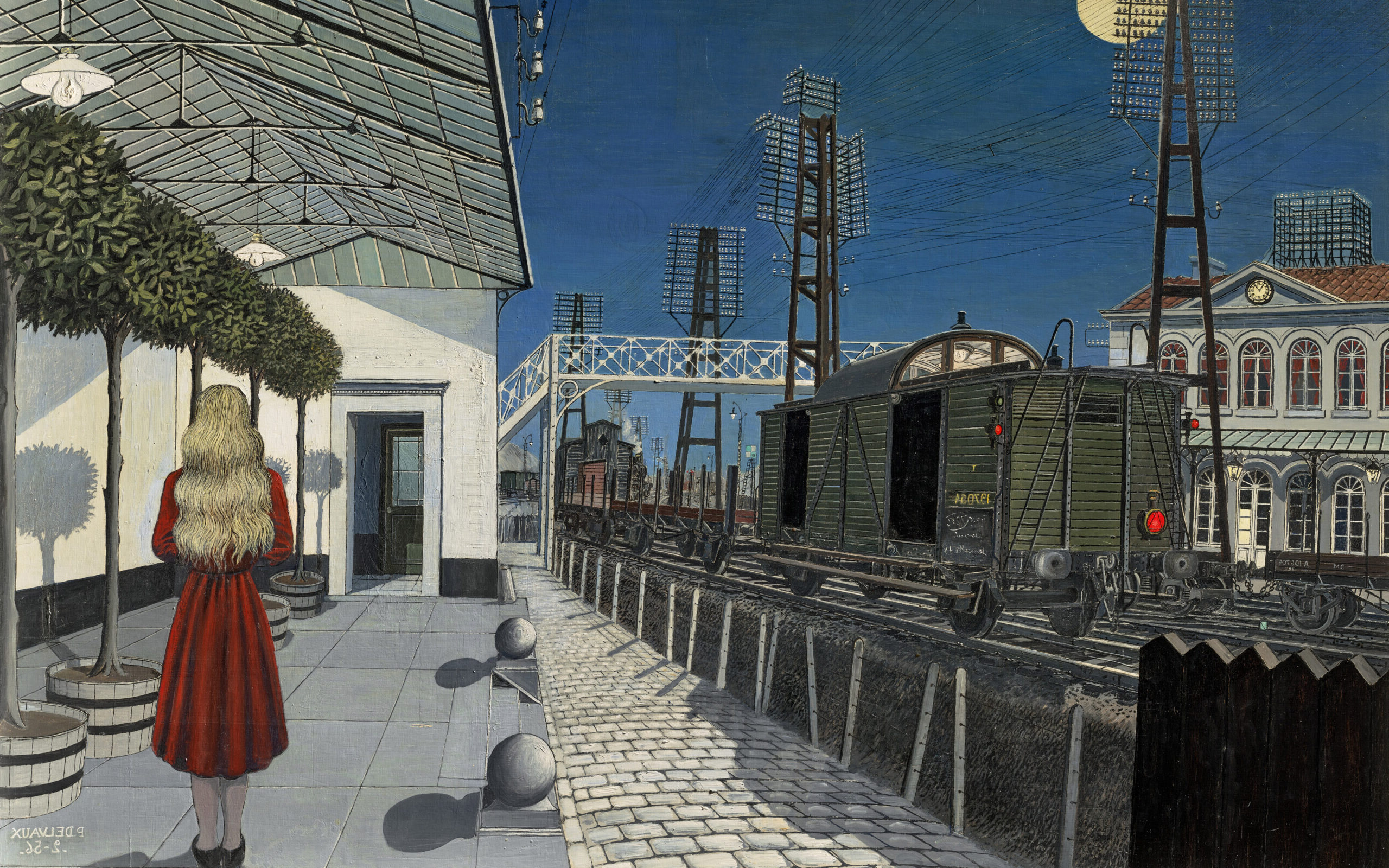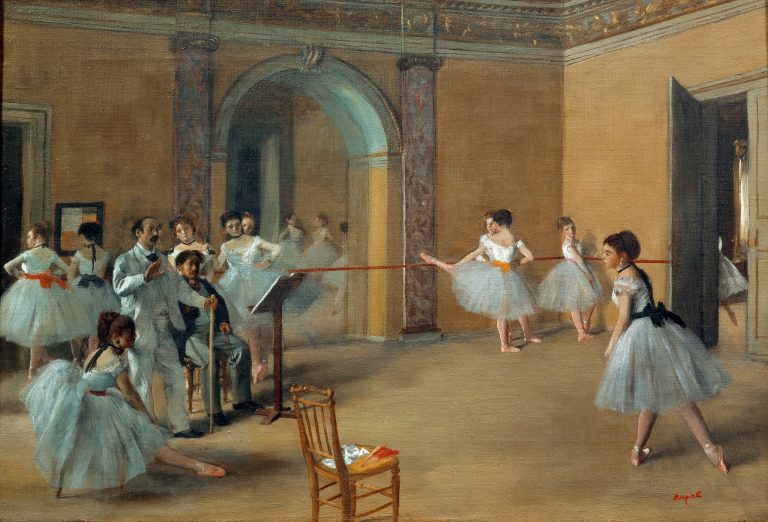Paul Delvaux Painter: A Master of Surrealist Imagery in the 20th Century
Born: 23 September 1897, Antheit, Belgium
Death: 20 July 1994, Veurne, Belgium
Art Movement: Surrealism
Nationality: Belgian
Influenced By: Giorgio de Chirico and René Magritte
Institution: Académie Royale des Beaux-Arts
Paul Delvaux Painter: A Master of Surrealist Imagery in the 20th Century
Life and Career Overview
Paul Delvaux was born on September 23, 1897, in Antheit, Belgium, and died on July 20, 1994. This Belgian painter became known for his association with the Surrealist movement, although he maintained a distinctive personal style.

Red City (1944) by Paul Delvaux
In his youth, Delvaux studied Ancient Greek and Latin, developing interests that would later influence his artistic themes. He received his formal education at the Académie des Beaux-Arts in Brussels, where he initially focused on academic traditions.
Delvaux’s early work was largely influenced by Expressionism. However, his artistic direction changed significantly after encountering the works of Giorgio de Chirico and René Magritte in the 1930s, leading him toward Surrealism.
His distinctive style featured dreamlike scenes with classical architecture, trains, and mysterious female figures. These recurring elements created a unique visual language that set him apart from other Surrealist painters.
Despite being associated with Surrealism, Delvaux never officially joined the movement. He maintained an independent approach while sharing certain thematic and stylistic elements with Surrealist painters.
Later in life, Delvaux settled in Saint-Idesbald, near Veurne, Belgium. He continued creating art well into his later years, expanding his work to include printmaking.
The Paul Delvaux Museum was established in Saint-Idesbald to preserve and showcase his artistic legacy, housing many of his important works and personal items.
Artistic Style and Influences
Paul Delvaux developed a distinctive artistic style that combined surrealism with classical elements. His work stands out for its dreamlike quality, technical precision, and recurring motifs that created an unmistakable visual language.
Surrealism and Symbolism
Delvaux’s association with surrealism began in the 1930s, though he never officially joined the movement. He was profoundly influenced by Giorgio de Chirico’s mysterious empty squares and René Magritte’s juxtaposition of ordinary objects in extraordinary contexts.
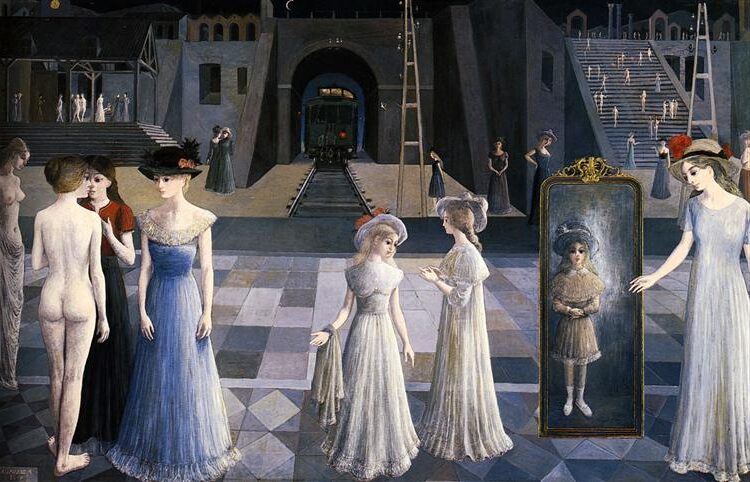
The Tunnel (1978) by Paul Delvaux
Unlike Salvador Dalí’s melting dreamscapes, Delvaux created more structured scenarios with deep psychological undertones. His paintings often featured symbolic elements like skeletons representing mortality, and men in bowler hats symbolizing bourgeois conformity.
Delvaux’s surrealism wasn’t about random associations but carefully constructed dreamscapes that explored themes of desire, anxiety, and alienation. His female figures, often nude and sleepwalking through strange environments, represented his complex relationship with femininity.
Classical Architecture and Dream-Like Scenes
Architecture played a crucial role in Delvaux’s compositions, reflecting his early architectural studies. Classical columns, Roman ruins, and Renaissance arcades created dramatic settings for his enigmatic narratives.
These architectural elements weren’t merely decorative but functioned as psychological spaces. Delvaux placed his figures in train stations, moonlit streets, and ancient ruins to create a sense of timelessness and displacement.
His scenes often depicted twilight or night, illuminated by an eerie moon or artificial lighting that cast dramatic shadows. This created the dreamlike quality that became his signature.
The precision with which he rendered these architectural details contrasted with the surreal situations, heightening the uncanny feeling in his work.
Hyper-Realistic Styling and Academic Painting
Delvaux’s technical approach was grounded in academic tradition, using meticulous brushwork and careful attention to anatomical details. This hyper-realistic styling set him apart from many contemporaries.
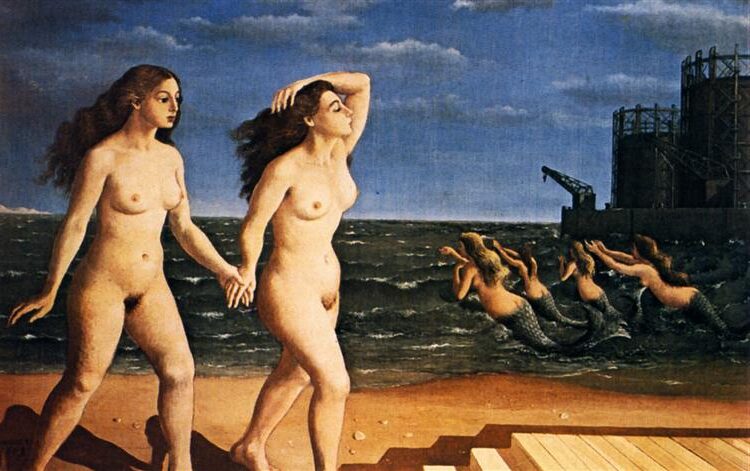
Woman in Front of the Sea (1943) by Paul Delvaux
Early influences of Impressionism and Post-Impressionism gradually gave way to a more precise rendering style. He maintained a consistent technical approach throughout his career, unlike many artists who experimented with multiple styles.
His figures were painted with classical precision, often resembling Greek or Roman statues in their poses and expressions. This academic approach to surrealism created a distinctive tension in his work.
The contrast between his realistic painting technique and fantastical subject matter amplified the dreamlike quality of his compositions, making ordinary elements seem strange and unfamiliar.
Key Works and Recurring Themes
Paul Delvaux‘s art features distinct motifs that appear throughout his career, creating a dreamlike universe filled with mysterious scenes. His work blends classical elements with modern settings in unexpected ways.
The Awakening of the Forest and Notable Paintings
“The Awakening of the Forest” (1939) stands as one of Delvaux’s most recognizable works. This painting depicts nude women wandering through a moonlit forest, creating an atmosphere of both enchantment and unease.
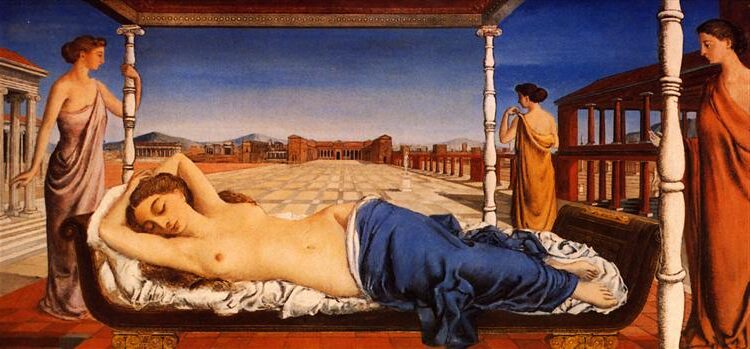
The Sleeping Venus (1943) by Paul Delvaux
Another significant painting is “Sleeping Venus” (1943), which shows Delvaux’s fascination with classical mythology. The reclining female figure appears in various forms throughout his career.
“The Call of the Night” (1938) demonstrates his mastery of nocturnal scenes. The painting combines architectural elements with female figures, blurring the line between reality and dreams.
Delvaux was influenced by Jules Verne’s scientific fiction, which inspired fantastical elements in his work. This influence appears in paintings like “The Village of the Mermaids” (1942), where scientific curiosity meets mythological creatures.
Trains and Train Stations
Train stations became a recurring setting in Delvaux’s art, representing both modernity and mystery. These spaces often appear deserted or frozen in time.

Popular Cry (1948) by Paul Delvaux
“The Viaduct” (1963) showcases his meticulous attention to detail in depicting train infrastructure. The technical precision contrasts with dreamlike elements, creating an unsettling atmosphere.
Delvaux frequently positioned nude figures near trains or within station waiting rooms. This unusual combination creates a sense of displacement that challenges viewers’ expectations.
The artist’s childhood fascination with railways developed into a symbolic element in his mature work. Trains in his paintings suggest movement and transition between different states of being or consciousness.
Nude Women and Skeletons
Female nudes appear in almost all of Delvaux’s major works. These women typically have blank expressions and classical poses, giving them a detached, statue-like quality.
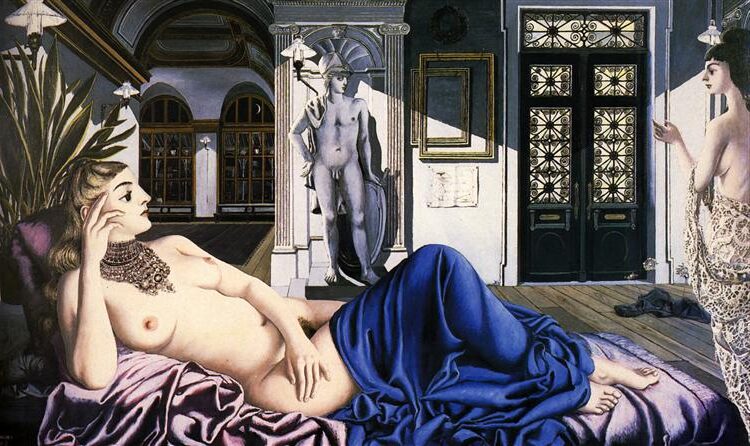
In Praise of Melancholy (1948) by Paul Delvaux
Unlike other surrealists, Delvaux portrays women without overt sexualization. Instead, they become symbolic figures representing both vulnerability and power within his dreamscapes.
Skeletons feature prominently as symbols of mortality. In “The Skeleton” (1944), the juxtaposition of death imagery with female nudity explores themes of desire and horror simultaneously.
Delvaux created bizarre combinations that challenge conventional thinking. In “Phases of the Moon” (1939), skeletons appear alongside nude women in an academic setting, reflecting his interest in the connection between scientific knowledge and human experience.
Frequently Asked Questions
Paul Delvaux’s unique artistic journey sparked curiosity among art enthusiasts and critics alike. His dreamlike paintings and distinctive style continue to intrigue viewers with their mysterious narratives and symbolic elements.
What artistic movement is Paul Delvaux associated with?
Paul Delvaux is primarily associated with Surrealism, although he never officially joined the Surrealist group. He developed his personal style in the late 1930s after being influenced by the works of Giorgio de Chirico and René Magritte.
Unlike many Surrealists who emphasized automatism, Delvaux created meticulously planned dreamscapes. His paintings combined classical architecture with enigmatic figures in a way that felt both realistic and deeply unsettling.
The artist himself sometimes resisted the Surrealist label. He preferred to see his work as a personal exploration of his inner world and recurring dreams.
How did Paul Delvaux’s early life influence his work?
Delvaux was born in 1897 in Antheit, Belgium, to a family that emphasized traditional values. His strict Catholic upbringing instilled a sense of moral tension that later emerged in his art.
His mother discouraged his early artistic interests, pushing him toward a legal career. This repression may have contributed to the themes of constraint and release in his later paintings.
As a youth, Delvaux developed fascinations with Jules Verne novels, Greek mythology, and trains. These childhood interests became recurring motifs throughout his artistic career.
Can you describe the common themes present in Paul Delvaux’s paintings?
Nude or partially clothed women appear frequently in Delvaux’s work, often portrayed with blank expressions in dreamlike settings. These figures represent both desire and emotional distance.
Classical architecture, including Roman columns and temples, creates theatrical backdrops for his mysterious scenes. These structures suggest permanence against the transient human figures.
Railway stations and trains symbolize journeys and transitions in many of his paintings. Skeletons, mirrors, and moons also appear regularly, adding layers of symbolic meaning about mortality and time.
What are some of the most notable works by Paul Delvaux, and where can they be viewed?
“The Sleeping Venus” (1944) stands as one of Delvaux’s masterpieces, featuring his signature combination of classical architecture and enigmatic female figures. It resides in the Tate Modern in London.
“The Village of the Mermaids” (1942) showcases his ability to create unsettling juxtapositions, with clothed men and naked women in an eerie nocturnal setting. It can be viewed at the Chicago Art Institute.
The Paul Delvaux Museum in Saint-Idesbald, Belgium houses the largest collection of his works. Major pieces can also be found in Brussels’ Royal Museums of Fine Arts and the Museum of Modern Art in New York.
How did Paul Delvaux’s style evolve throughout his career?
Delvaux began as an Expressionist painter in the 1920s, focusing on landscapes and still lifes. His early work showed influences from Flemish Expressionism and Post-Impressionism.
After discovering Surrealism in the 1930s, his style transformed dramatically. He developed his characteristic dreamlike scenes featuring classical architecture and mysterious female figures.
In his later years, Delvaux simplified his compositions while maintaining his distinctive imagery. His last works, created in the 1980s, often returned to childhood themes with greater serenity and less erotic tension.
What impact did Paul Delvaux have on modern art, particularly in Surrealism?
Delvaux expanded Surrealism’s visual vocabulary by combining classical precision with dreamlike imagery. His technical mastery demonstrated that Surrealist concepts could be executed with traditional painting skills.
His work influenced later generations of figurative painters interested in psychological narrative. Artists like Neo Rauch have acknowledged Delvaux’s impact on their approach to dreamlike figurative scenes.
Delvaux’s unique treatment of the female form sparked important discussions about gender representation in modern art. His work continues to provoke debate about the male gaze and objectification in Surrealist art.

